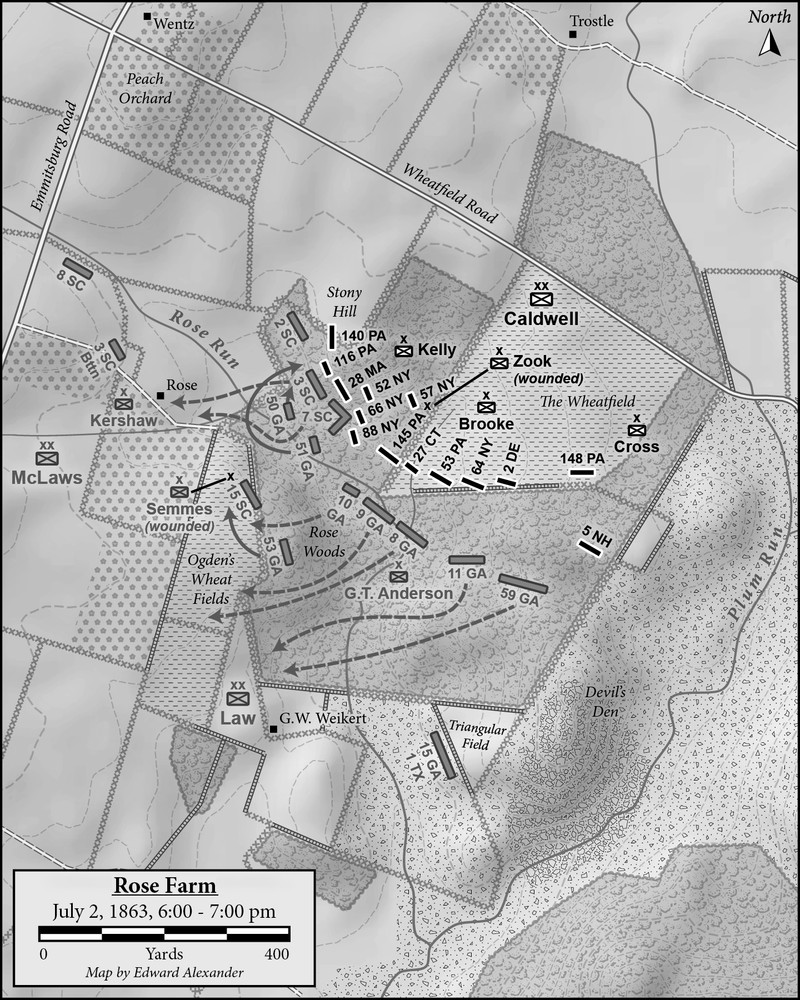A Little Piece of Hell at Gettysburg: The Attack and Defense of the Rose Farm, July 2-3, 1863
- Current Stock:
- Author:
- Scott T. Fink
- Pub Date:
- 2026
- ISBN:
- 978-1-61121-752-0
- eISBN:
- 978-1-61121-753-7
- Binding:
- Cloth, d.j., 6 x 9
- Specs:
- 76 images, 10 maps, 384 pages
- Bookplates:
- Available
"Of the many historic farms on the battlefield of Gettysburg, the complete story of
the George Rose farm has never been fully told until now."
-- John S. Heiser, Historian, National Park Service (ret.)
eBook coming soon!
Click HERE to read the Front Matter and Chapter 1
The unassuming stone farmhouse, where John and Ann Rose and their seven children lived, stood amid 230 acres of verdant land on the eastern side of the Emmitsburg Road about two miles south of Gettysburg. On July 2, 1863, this patch of ground—sandwiched between Little Round Top to the south and the Peach Orchard to the north—became a vortex for tens of thousands of men as the armies renewed the second day of battle. Scott Fink’s A Little Piece of Hell at Gettysburg: The Attack and Defense of the Rose Farm, July 2–3, 1863, is the first full-length study of the Rose farm fighting and its significance.
Confederates under James Longstreet swept across the Rose farm from different directions in a bid to crush Maj. Gen. George Meade’s left flank. The Rose land, which included the Stony Hill and the Rose Woods, saw some of the heaviest fighting of the war as thousands of Georgians and South Carolinians flooded onto the property from the west and southwest into sheets of lead and iron. One of the fields, a 20-acre plot across which some 20,000 men of both armies would march, charge, fight, and die—often in hand-to-hand combat—is better known today as the Wheatfield. Union soldiers from several corps, arriving from different parts of the field, rushed into the swirling chaos to stem the break in the line and hold fast. Heavy musketry fire and death-dealing artillery rounds littered the ground and surrounding woodlots with wounded and dead soldiers, earning it the grim distinction as the bloodiest farm in American history.
The Confederates used the house and barn for shelter and, after the fighting, as a field hospital. Between 500 and 1,000 Southerners were buried on the Rose property. Alexander Gardner took some of the most famous photographs of the war there, mostly of dead Georgians from George T. Anderson’s Brigade. One of Rose’s daughters suffered from chronic nightmares and bouts of hysteria (better known today as PTSD). The doctor treating her surmised she was “driven mad” and prescribed the use of a straitjacket. Her father believed the anxiety was the result of hundreds of Confederate graves littering the property.
Scott Fink’s A Little Piece of Hell at Gettysburg draws on deep research and moving prose that carries readers through every stage of the fighting. The author, himself a combat veteran, carefully examines the battle from the perspective of both the generals who planned it and the men in the ranks who fought it. His use of scores of archival and firsthand accounts, together with original maps, explanatory footnotes, and a keen understanding of the terrain, sheds significant new light on the experiences of these front-line troops and the iconic post-battle photographs. The fighting on the Rose farm played a critical role in the fortunes of both armies at Gettysburg. This mre original study helps put the sacrifices of those who fought there in context.
Advance Praise
“There are quite a few battle of Gettysburg micro-histories, but Scott Fink’s A Little Piece of Hell at Gettysburg: The Attack and Defense of the Rose Farm stands out for the depth of its research. Besides providing a thorough examination of the brutal fighting that swirled about the Rose farm during the battle, he offers an exhaustive analysis of the famous series of photos of the Confederate dead on the farm. Surely a book anyone with an interest in Gettysburg will want to read.” — D. Scott Hartwig, author of I Dread the Thought of the Place: The Battle of Antietam and the End of the Maryland Campaign
“Numerous historians have stated there is nothing new to say about Gettysburg. This book proves them wrong.” — Keith Poulter, founder and editor of North & South Magazine
“Scott Fink’s new book demonstrates there is still ample room for a well-written and deeply researched micro-account of understudied segments of the battle. He deftly weaves dozens of first-person accounts into a compelling narrative.” — Scott L. Mingus, Sr., author of Flames Beyond Gettysburg: The Confederate Expedition to the Susquehanna River, June 1863
“Of the many historic farms on the battlefield of Gettysburg, the complete story of the George Rose farm has never been fully told until now. A Little Piece of Hell at Gettysburg: The Attack and Defense of the Rose Farm provides the reader with an in-depth look into the events leading up to that fateful day, the swirl of combat over and around Rose’s homestead, and the tragic aftermath that draws so much attention to this site today. Scott Fink’s meticulous research fulfills a greater goal: restoration of the human element regarding the tragic deaths of young Americans so very far from home. That alone makes this book a worthwhile read.” — John S. Heiser, Historian, National Park Service (ret.)
“The ferocious combat that raged around the Rose farm has long been relegated to a footnote in the broader narrative of Gettysburg. Scott Fink’s insightful work reclaims the farm’s significance, illustrating how a once peaceful patch of land was transformed into ‘a little piece of hell.’ With a rich assortment of archival testimony, original maps, vivid photos, and moving prose, he painstakingly captures the personal costs exacted by the ‘whirlpool’ that was Gettysburg’s infamous Wheatfield. More than just a military history, this is a profound study of human endurance and battlefield detective work. Meticulously researched and elegantly written, this is an eye-opening account of how one farm became a landmark representative of the Civil War’s heroism and horror.” — Dr. Jared Frederick, author of Gettysburg National Military Park
Scott T. Fink attended Towson University and graduated from the Washington School of Photography, both in his home state of Maryland. He served in the U.S. Army and Maryland Army National Guard for nearly 19 years and retired as a Staff Sergeant. Scott has been an avid student of the Civil War for many years and has spent much of the last decade studying Gettysburg in general, and Gettysburg photographs in particular. He has authored several articles published in Civil War Times and Gettysburg Magazine. A Little Piece of Hell at Gettysburg is his first book. An Iraq War veteran and Purple Heart recipient, Scott lives in Olney, Maryland, with his wife, three children, and two dogs.









